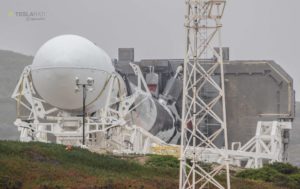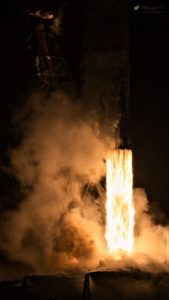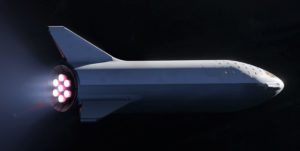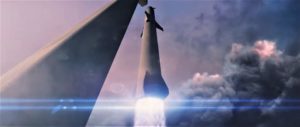

News
SpaceX ships another huge propellant tank to South Texas BFR test site
Captured by NASASpaceflight.com forum user “bocachicagal”, the second of several massive liquid methane tanks has arrived at SpaceX’s prospective Boca Chica, Texas facilities, to be dedicated to integrated testing of BFR’s spaceship/upper stage.
If there was any doubt beforehand, the arrival of a second ~100,000 gallon vacuum-insulated tank all but guarantees that SpaceX is planning a major campaign of BFR spaceship testing in South Texas – with as much as 200,000 gallons of storage capacity in those two tanks alone, SpaceX could easily top off two Falcon 9’s with liquid oxygen and still have more than 100 tons left over.

Per NASASpaceflight.com’s forums, it appears that this newest tank arrived at the site sometime yesterday or the day before. Thanks to the fundamental properties of BFR’s planned liquid methane and oxygen fuel and oxidizer, aspects of basic ground support infrastructure may actually be a significant improvement over Falcon 9’s refined kerosene (RP-1) and liquid oxygen, and dramatically superior (at least in a logistical and practical sense) to hydrogen/oxygen, a popular choice for many rockets.
In terms of volume and density, oxygen is about 2.5x denser than methane but optimally combusts at a ratio of roughly 3.5 parts oxygen to 1 part methane (3.5:1), with SpaceX likely to operate the Raptor engine closer to 3.8:1. This means that – despite their major density differences – BFR’s oxygen and methane tanks will ultimately end up very similarly sized to hold ~230t of liquid methane and ~860t of liquid oxygen (2017 BFR numbers).
Testing giant rockets: it’s not easy
As it relates to SpaceX’s South Texas propellant infrastructure, this likely means that a minimum of four large vacuum-insulated tanks will be needed to fully fuel a BFR spaceship (BFS), two for oxygen (~800t) and two for methane (~300t). Depending on how SpaceX has structured its BFR infrastructure acquisitions, the two large tanks now present in Boca Chica could be more than enough to support a wide range of spaceship hop tests. A full load of fuel is almost certainly unnecessary – if not outright implausible – for BFS hop testing: with a full load of ~1100t of fuel and the spaceship’s total mass around ~1250t, all seven planned Raptor engines would need to be installed and operating near full thrust (~1400t, 14,000 kN) to lift the ship off the ground.
- F9R seen just before liftoff for a 2014 hop test at SpaceX’s McGregor, TX test facilities. BFR’s first test pad might (or might not) look quite similar. (SpaceX)
- An updated spaceship lands on Mars. (SpaceX)
For context, Falcon 9’s first stage produces a maximum thrust of roughly 7,600 kN at liftoff, while Falcon Heavy triples that figure to ~22,800 kN. The spaceship/upper stage of BFR alone thus produces nearly two times as much thrust as an entire Falcon 9 at full throttle and as much as fourteen times as much thrust as Falcon 9 and Heavy’s upper stage, statistics that properly illustrate just how extraordinarily powerful BFR is when compared with the rockets SpaceX currently operates. BFR’s booster (BFB) is even wilder, featuring ~3.5 times as many Raptors and thus ~3.5 times as much thrust as the spaceship/upper stage.
As a result of the sheer power of just the spaceship alone, SpaceX may have to move directly to a style of launch pad closer to that used by Falcon 9 and Heavy rather than the spartan concrete slab used for Falcon 9’s Grasshopper testing. In this case, the rocket would be mounted some distance from the ground to minimize acoustic loads on the vehicle’s after and would likely include a water deluge system to further deaden thermal and acoustic energy while also minimizing damage to the concrete and metal structures that launch and landing pads are built out of.
- Prior to liftoff, Falcon 9 and Falcon Heavy are held down by massive “hold-down clamps” at the rocket’s base. Even after engine ignition, those clamps only release once the flight computer decides that the rocket is healthy. (Pauline Acalin)
- Falcon 9 B1049 lifts off from SpaceX’s LC-40 pad on September 10, producing more than 1.7 million pounds of thrust.(Tom Cross)
- A September 2018 render of Starship (then BFS) shows one of the vehicle’s two hinged wings/fins/legs. (SpaceX)
- BFR’s booster is at least three times more powerful still than BFS at liftoff. (SpaceX)
Above all else, the presence of not one but two huge ~100,000-gallon vacuum-insulated tanks at SpaceX’s Boca Chica facilities all but guarantees that the company intends to situate a serious campaign of BFR tests there, likely including the integrated spaceship hop tests both Elon Musk and Gwynne Shotwell have explicitly mentioned in recent months. Put simply, SpaceX has no other reason to be bringing massive cryogenic propellant tanks to South Texas – the company has plenty of space at any one of its three large launch complexes (not to mention McGregor) if it wanted to store those tanks elsewhere, and those three facilities already have operational propellant storage and loading infrastructure for Falcon 9 and Heavy launches.
If more massive tanks continue to arrive or if it becomes clear that the two similar tanks present or solely meant for LOX or methane, the scale of SpaceX’s intentions in South Texas will become increasingly clearer.
For prompt updates, on-the-ground perspectives, and unique glimpses of SpaceX’s rocket recovery fleet check out our brand new LaunchPad and LandingZone newsletters!

News
Elon Musk’s Grok AI to be used in U.S. War Department’s bespoke AI platform
The partnership aims to provide advanced capabilities to 3 million military and civilian personnel.

The U.S. Department of War announced Monday an agreement with Elon Musk’s xAI to embed the company’s frontier artificial intelligence systems, powered by the Grok family of models, into the department’s bespoke AI platform GenAI.mil.
The partnership aims to provide advanced capabilities to 3 million military and civilian personnel, with initial deployment targeted for early 2026 at Impact Level 5 (IL5) for secure handling of Controlled Unclassified Information.
xAI Integration
As noted by the War Department’s press release, GenAI.mil, its bespoke AI platform, will gain xAI for the Government’s suite of tools, which enable real-time global insights from the X platform for “decisive information advantage.” The rollout builds on xAI’s July launch of products for U.S. government customers, including federal, state, local, and national security use cases.
“Targeted for initial deployment in early 2026, this integration will allow all military and civilian personnel to use xAI’s capabilities at Impact Level 5 (IL5), enabling the secure handling of Controlled Unclassified Information (CUI) in daily workflows. Users will also gain access to real‑time global insights from the X platform, providing War Department personnel with a decisive information advantage,” the Department of War wrote in a press release.
Strategic advantages
The deal marks another step in the Department of War’s efforts to use cutting-edge AI in its operations. xAI, for its part, highlighted that its tools can support administrative tasks at the federal, state and local levels, as well as “critical mission use cases” at the front line of military operations.
“The War Department will continue scaling an AI ecosystem built for speed, security, and decision superiority. Newly IL5-certified capabilities will empower every aspect of the Department’s workforce, turning AI into a daily operational asset. This announcement marks another milestone in America’s AI revolution, and the War Department is driving that momentum forward,” the War Department noted.
News
Tesla FSD (Supervised) v14.2.2 starts rolling out
The update focuses on smoother real-world performance, better obstacle awareness, and precise end-of-trip routing, among other improvements.

Tesla has started rolling out Full Self-Driving (Supervised) v14.2.2, bringing further refinements to its most advanced driver-assist system. The new FSD update focuses on smoother real-world performance, better obstacle awareness, and precise end-of-trip routing, among other improvements.
Key FSD v14.2.2 improvements
As noted by Not a Tesla App, FSD v14.2.2 upgrades the vision encoder neural network with higher resolution features, enhancing detection of emergency vehicles, road obstacles, and human gestures. New Arrival Options let users select preferred drop-off styles, such as Parking Lot, Street, Driveway, Parking Garage, or Curbside, with the navigation pin automatically adjusting to the user’s ideal spot for precision.
Other additions include pulling over for emergency vehicles, real-time vision-based detours for blocked roads, improved gate and debris handling, and extreme Speed Profiles for customized driving styles. Reliability gains cover fault recovery, residue alerts on the windshield, and automatic narrow-field camera washing for new 2026 Model Y units.
FSD v14.2.2 also boosts unprotected turns, lane changes, cut-ins, and school bus scenarios, among other things. Tesla also noted that users’ FSD statistics will be saved under Controls > Autopilot, which should help drivers easily view how much they are using FSD in their daily drives.
Key FSD v14.2.2 release notes
Full Self-Driving (Supervised) v14.2.2 includes:
- Upgraded the neural network vision encoder, leveraging higher resolution features to further improve scenarios like handling emergency vehicles, obstacles on the road, and human gestures.
- Added Arrival Options for you to select where FSD should park: in a Parking Lot, on the Street, in a Driveway, in a Parking Garage, or at the Curbside.
- Added handling to pull over or yield for emergency vehicles (e.g. police cars, fire trucks, ambulances).
- Added navigation and routing into the vision-based neural network for real-time handling of blocked roads and detours.
- Added additional Speed Profile to further customize driving style preference.
- Improved handling for static and dynamic gates.
- Improved offsetting for road debris (e.g. tires, tree branches, boxes).
- Improve handling of several scenarios, including unprotected turns, lane changes, vehicle cut-ins, and school buses.
- Improved FSD’s ability to manage system faults and recover smoothly from degraded operation for enhanced reliability.
- Added alerting for residue build-up on interior windshield that may impact front camera visibility. If affected, visit Service for cleaning!
- Added automatic narrow field washing to provide rapid and efficient front camera self-cleaning, and optimize aerodynamics wash at higher vehicle speed.
- Camera visibility can lead to increased attention monitoring sensitivity.
Upcoming Improvements:
- Overall smoothness and sentience.
- Parking spot selection and parking quality.
News
Tesla is not sparing any expense in ensuring the Cybercab is safe
Images shared by the longtime watcher showed 16 Cybercab prototypes parked near Giga Texas’ dedicated crash test facility.

The Tesla Cybercab could very well be the safest taxi on the road when it is released and deployed for public use. This was, at least, hinted at by the intensive safety tests that Tesla seems to be putting the autonomous two-seater through at its Giga Texas crash test facility.
Intensive crash tests
As per recent images from longtime Giga Texas watcher and drone operator Joe Tegtmeyer, Tesla seems to be very busy crash testing Cybercab units. Images shared by the longtime watcher showed 16 Cybercab prototypes parked near Giga Texas’ dedicated crash test facility just before the holidays.
Tegtmeyer’s aerial photos showed the prototypes clustered outside the factory’s testing building. Some uncovered Cybercabs showed notable damage and one even had its airbags engaged. With Cybercab production expected to start in about 130 days, it appears that Tesla is very busy ensuring that its autonomous two-seater ends up becoming the safest taxi on public roads.
Prioritizing safety
With no human driver controls, the Cybercab demands exceptional active and passive safety systems to protect occupants in any scenario. Considering Tesla’s reputation, it is then understandable that the company seems to be sparing no expense in ensuring that the Cybercab is as safe as possible.
Tesla’s focus on safety was recently highlighted when the Cybertruck achieved a Top Safety Pick+ rating from the Insurance Institute for Highway Safety (IIHS). This was a notable victory for the Cybertruck as critics have long claimed that the vehicle will be one of, if not the, most unsafe truck on the road due to its appearance. The vehicle’s Top Safety Pick+ rating, if any, simply proved that Tesla never neglects to make its cars as safe as possible, and that definitely includes the Cybercab.














